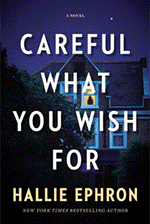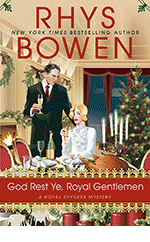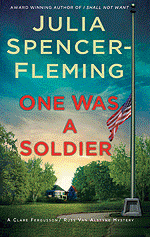 JULIA SPENCER-FLEMING: This weekend I get my two best Christmas presents: Virginia flies in
JULIA SPENCER-FLEMING: This weekend I get my two best Christmas presents: Virginia flies in
from Amsterdam today and Spencer arrives from Norfolk tomorrow. Hopefully, their flights will
go smoothly and traffic to and from Boston won’t be too bad.
Thanksgiving is apparently THE biggest travel period in the US, but Christmas is a close second,
and extends throughout the Americas, Europe, and significant parts of Asia and Africa. That’s a
LOT of people on the move!
The one time I’ve flown to get someplace FOR Christmas was the year Ross passed away, when
we decided to escape to Hawai’i. Everything went smoothly, and thanks to the fact Spencer was
an active-duty service member, we got to crash in the Bob Hope lounge at LAX, along with
roughly 50% of the rest of the armed forces of the US.
The rest of my holiday travel has always been by car, and there have been some adventures. When
I was a teen, we lived in Syracuse and went across eastern NY state every Christmas day to gather
at my grandmother’s. Even as a self-absorbed kid, I recall the year it was snowing and blowing
every inch of the way, with my dad white-knuckled on the steering wheel and my mom searching
the map for anyplace we might stay if we had to abandon the Thruway. And these trips took place
BEFORE 24-hour gas stations and always-open mom-and-pop stores.
 Then there was the time Ross and I, new parents, were meeting his dad at the Trapp Family Lodge
Then there was the time Ross and I, new parents, were meeting his dad at the Trapp Family Lodge
in Vermont. What could be more perfectly Christmas? Again, the weather in the Northeast wasn’t
cooperative, and this time it was my husband clenching the wheel while I kept my eyes on the
map. It took us at least twice as long as we had planned, and starving, we pulled through a Burger
King drive-in. What a great opportunity to give fifteen-month-old Victoria her very first french
fries! (We were not ordinarily fast food people.)
Whether it was the grease, or the processed potato, or just the swaying of the Bronco as we were
buffeted by the wind, but as we crawled up the road to the resort, the baby threw up
EVERYTHING. On her cute outfit. On her car seat. On the car’s BACK seat. Merry Christmas,
Granddad!
How about you, Reds? Any memorable holiday season travels?
 RHYS BOWEN: When I was a small child we drove to my grandmother’s house every Christmas
RHYS BOWEN: When I was a small child we drove to my grandmother’s house every Christmas
Eve, buying the tree along the way and strapping it to the roof of the car. I don’t know how we
managed to bring four of us, presents and a tree in a small British car, but we did. Then we’d
decorate the tree that evening and we kids would go to bed, full of excitement. Christmas Day
was always simple but lovely: opening gits, big breakfast, church in morning then mid afternoon
turkey dinner, Queen’s speech and lazy evening.
My one dramatic Christmas was when I was chatting with a friend who is German and who
lamented the commercialism of Christmas in America. We decided to rent a house up at Lake
Tahoe in the snow (at great expense). We arrived. It was perfect, Christmas card scene in the
mountains. Then… she came down with the worst cold ever, she had forgotten to bring the
cookies she had baked. She went to bed, leaving all the cooking etc to me. The first morning
we went skiing… Lovely, until it started to snow, then blizzard. Jane and Andrew, up on the
black diamond slopes, had to be brought down. Then the snow turned to rain and it rained
solidly for the rest of the time we were up there. No TV. Pouring rain. Everyone tired of board
games. Not the best memory!
 HALLIE EPHRON: Christmas for me, growing up, was low key and at home. Our tradition, if
HALLIE EPHRON: Christmas for me, growing up, was low key and at home. Our tradition, if
we had any, was to buy a tree on the night BEFORE the night before Christmas. Me and my 3
sisters piled into the car for the cruise up and down Santa Monica and Wilshire Boulevards,
stopping at the Christmas tree lots on the edges of parking lots (before every spare corner of
Los Angeles was built upon).
We’d stake out our favorite tree, my father would negotiate, and then strap it to the roof of our car.
It was always enormous, despite my mother’s desperate pleas for “something small this year.”
Invariably my father had to cut the top off before he could wrestle it through the front door and
into our 2-story front hall where it would stand until the day after New Year when my mother
would dismantle it.
We’d decorate it Christmas eve. And come down to it lit up on Christmas morning with gifts
piled high around it. Our Christmas was all about the food and the gifts and Santa Claus and
Christmas carols.
I’d never lit a Hanukah candle until I married Jerry, and that’s when I stopped having a tree.
It was just about the only thing on which we did not see eye to eye, but it just never mattered
that much to me, and though he wasn’t religious, it mattered to him. You learn to pick your
battles.
 LUCY BURDETTE: I have only two semi-disastrous memories. One, I was driving home to New
LUCY BURDETTE: I have only two semi-disastrous memories. One, I was driving home to New
Jersey from my grad program at UT Knoxville. I had my two cats in a big old Ford Falcon station
wagon, along with a woman passenger who wanted a ride. The weather was horrendous, icy and
snowy and scary. We fishtailed our way north with the cats scraping frantically at the back window
. I’m lucky to have survived that one!
Another was also a trip from Tennessee to NJ, this time on a Greyhound bus. I believe it was an
overnight trip sitting up, with a very drunk man in front of us who wanted the whole bus to sing
Christmas carols. “Come on people, let’s sing!” he shouted through most of the trip. Not to be
repeated!
HANK PHILLIPPI RYAN: Holiday travel? Well, hmm, what I can remember was the time in
college when instead of driving back to school in January after Christmas vacation, my boyfriend
and I decided to drive to New York. Just for fun. (My college was in Ohio, and his in Indiana.) As
we got into Sam’s car, my mom said “Safe travels back to school!”
And I said, “Oh Mom, we are actually going to New York!”
And she said, “sure you are, have fun.”
 She thought we were kidding.
She thought we were kidding.
We weren’t.
We drove ALL the way to New York, a trip about which I have zero memories (except learning
that Ohio and Pennsylvania are huge,) walked around in the snow in the city and looked at
decorations, stayed at some hotel, NO idea, and then drove back. I missed two days of classes,
and told the dean it was for personal reasons, and looked sad.
She did not pursue it, and all was fine.
Is that a holiday story, or what?
DEBORAH CROMBIE: I am again the boring one here, but maybe that is not a bad thing!
Growing up, Christmas was always at our house, no traveling involved. Then when I was in my
late teens and early twenties, we had a few Christmases in the house my parents owned at the
time outside of Guadalajara. December in that part of Mexico is lovely, as are the Mexican
Christmas traditions. My only disappointment was not having a Christmas tree, but there was an
atrium in the center of the house and my mom and I strung colored lights on the plants and up the
stair rail, so all was fine.
It occurs to me that the Christmas I lived in England is a complete blank in my memory, other
than that I was terribly homesick.
JENN McKINLAY: My favorite holidays are the traveling ones. We're a beachie peoples and usually meet our east coast fam in Florida or California for a beach Christmas every few years just to break up the same old same old. The only disaster to date was when six month old Hooligan 2 got a righteous case of croup in Daytona and began barking in the middle of the night. A steamy bathroom didn't calm his cough, so in full panic mode we ended up with six burly fireman (there's a rule that they have to be hot, isn't there?) taking care of our wee man and then having baby and me go in an ambulance to the hospital just in case. It was my first and only ride in an ambulance and I'd like to keep it that way. That was our first night on the trip and from there on out it was smooth sailing...phew.
JULIA: How about you, dear readers? What are your holiday travel memories?






.jpg)





















